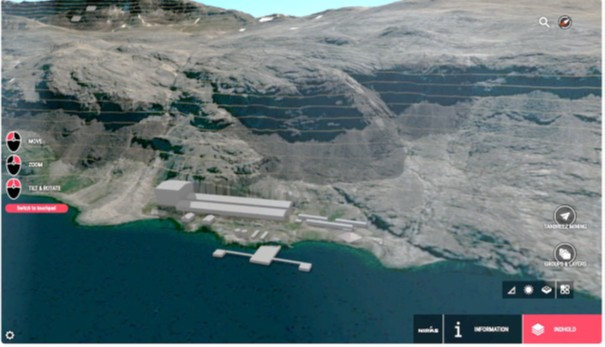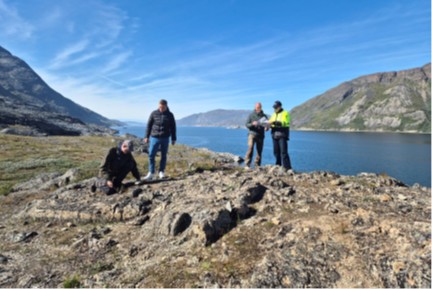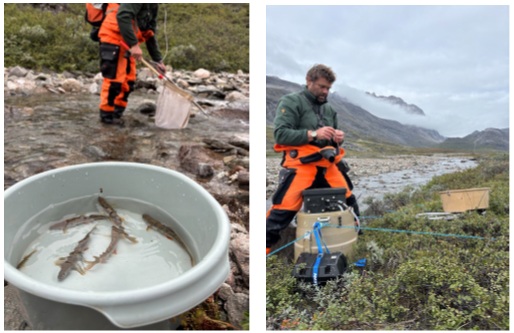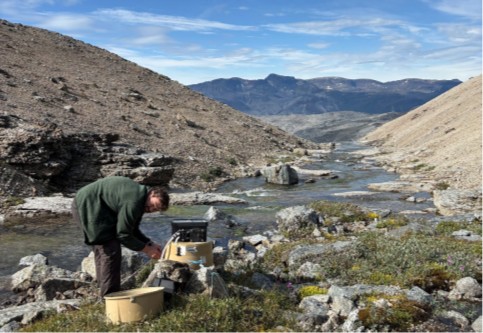
September 02, 2025
Critical Metals Corp. (Nasdaq: CRML) (“Critical Metals Corp” or the “Company”), a leading critical minerals mining company, today announced that Tanbreez Mining Greenland A/S (“Tanbreez”) is approximately 70% complete on the final stages of the Bankable Feasibility Study (BFS) for a 500,000 tons per annum mining and processing operation at the Tanbreez Rare Earth Project in South Greenland. The BFS is being led by Danish engineering firm NIRAS A/S (“NIRAS”), a globally leading multidisciplinary engineering and environmental consultancy based in Denmark. The BFS remains on track for submission in Q4 2025. In addition, NIRAS has completed environmental fieldwork for the 2025 baseline sampling program.
Tony Sage, Executive Chairman of the Company, commented:
“The progress on the final BFS engineering and the completion of the 868 baseline sampling program represent a major milestone in unlocking the full potential of the Tanbreez Rare Earth Project. Our partnership with NIRAS ensures that both technical and environmental aspects are being addressed to the highest standards, reinforcing our commitment to responsible development.”
This final BFS phase includes:
• Completion of mine design and process plant engineering
• Tailings management and water treatment strategies
• Integration of environmental and regulatory inputs
• Preparation of documentation for submission to Greenland’s MLSA

Figure 1. Proposed plant and port site.
The engineering scope encompasses detailed design of the two open pit mining phases, including blasting and haulage logistics, crushing and magnetic separation circuits, slurry transport systems, and tailings deposition infrastructure at Lake Foster. It also includes port and haul road layouts, diesel power generation, and worker accommodation facilities. NIRAS is integrating hydrological modelling, dust dispersion controls, and closure planning into the final design to ensure long-term environmental compliance, operational efficiency, and alignment with Greenland’s regulatory framework.

Figure 2 – NIRAS engineers at the proposed Tanbreez port site 27/8/2025
Once completed, which is expected in the fourth quarter of 2025, the BFS will form the central component of the Tanbreez updated Exploitation License documentation, to be submitted to the Mineral License and Safety Authority (MLSA) of Greenland, in accordance with the Greenlandic Mineral Resources Act and the specific terms of the granted exploitation license MIN 2020-54.

Figure 3 – NIRAS team undertaking August 2025 baseline marine sampling
This submission will support the progression of the project towards final approval to commence potential commercial mining operations.

Figure 4 - NIRAS FS finalization team
Completion of 2025 Baseline Sampling Program
In parallel, Critical Metals Corp confirms that environmental fieldwork for the 2025 baseline sampling program has officially been completed. This program—coordinated by NIRAS ran through August 2025 and was designed to close spatial and seasonal gaps in the existing baseline dataset.
Key components of the sampling campaign included:
- Bergerhoff dust monitoring
- All-year freshwater sampling across 19 stations
- Sediment coring in Lake Foster and Kangerluarsuk Fjord
- Arctic char population update via electrofishing
- Intertidal sampling of mussels, bladderwrack, and sea scorpion

Figure 5 – NIRAS team undertaking baseline marine fauna sampling August 2025
These efforts support the Environmental Impact Assessment (EIA) and reinforce Tanbreez’s commitment to responsible development.
About NIRAS
With nearly 70 years of experience, NIRAS has grown from a Danish consultancy into an international leader in sustainable progress. Founded by visionary engineers Jørgen Kristian Nielsen and Konrad Rauschenberger in 1956, NIRAS’s early projects in Greenland laid the foundation for their expertise in resilient and innovative solutions. Their decentralized structure fosters local expertise, adaptability and collaboration across borders and disciplines, ensuring sustainable value creation for their clients and the communities they serve.
As a multidisciplinary consultancy company with more than 3,000 employees located in 62 offices across Europe, Africa, Asia, North, and South America, NIRAS work within multiple areas from processing plants and construction over energy, water, environment, and infrastructure to third world aid and urban planning. NIRAS have 8,000 ongoing projects in more than 140 countries and their trademark is the crosscutting approach, always grounded and tailored to achieve the best outcomes for their clients and communities.
About Tanbreez
The Tanbreez Rare Earth Project is one of the world’s largest hard rock rare earth elements (REE) deposits, located in southern Greenland near the town of Qaqortoq. The project is notable for its high concentration of heavy rare earth oxides (HREOs), which are critical for high-tech applications, clean energy, and defence industries. Unlike other major TREO deposits, Tanbreez contains very low levels of uranium and thorium, making it more environmentally and politically viable.
- Deposit Type: Kakortokite (a stratiform layered igneous rock rich in TREOs)
- Kakortokite Estimate: ~4.7 billion tonnes of REE-bearing mineralisation
- Heavy REE Content: ~27% of Total Rare Earth Oxides (TREO)
- Location: Near Qaqortoq, southern Greenland
- Target drilling: ongoing to achieve Measured and Indicated Mineral Resources
- Project Stage: advanced Bankable Feasibility Study phase
Kakortokite host may not always contain any economic mineralisation of TREO.
About Critical Metals Corp.
Critical Metals Corp (Nasdaq: CRML) is a leading mining development company focused on critical metals and minerals, and producing strategic products essential to electrification and next generation technologies for Europe and its western world partners. Its flagship Project, Tanbreez, is one of the world's largest rare earth deposits and is located in Southern Greenland. The deposit is expected to have access to key transportation outlets as the area features year-round direct shipping access via deep water fjords that lead directly to the North Atlantic Ocean.
Another key asset is the Wolfsberg Lithium Project located in Carinthia, 270 km south of Vienna, Austria. The Wolfsberg Lithium Project is the first fully permitted mine in Europe and is strategically located with access to established road and rail infrastructure and is expected to be the next major producer of key lithium products to support the European market. Wolfsberg is well positioned with offtake and downstream partners to become a unique and valuable asset in an expanding geostrategic critical metals portfolio.
With this strategic asset portfolio, Critical Metals Corp is positioned to become a reliable and sustainable supplier of critical minerals essential for defense applications, the clean energy transition, and next-generation technologies in the western world.
For more information, please visit https://www.criticalmetalscorp.com/.
Cautionary Note Regarding Forward Looking Statements
This news release contains forward-looking statements within the meaning of Section 27A of the Securities Act of 1933, as amended, and Section 21E of the Securities Exchange Act of 1934, as amended (the “Exchange Act”). Forward-looking statements may include expectations of our business and the plans and objectives of management for future operations. These statements constitute projections, forecasts and forward-looking statements, and are not guarantees of performance. Such statements can be identified by the fact that they do not relate strictly to historical or current facts. When used in this news release, forward-looking statements may be identified by the use of words such as “estimate,” “plan,” “project,” “forecast,” “intend,” “will,” “expect,” “anticipate,” “believe,” “seek,” “target,” “designed to” or other similar expressions that predict or indicate future events or trends or that are not statements of historical facts. In addition, any statements that refer to projections, forecasts or other characterizations of future events or circumstances, including any underlying assumptions, are forward-looking statements.
Forward-looking statements are subject to known and unknown risks and uncertainties and are based on potentially inaccurate assumptions that could cause actual results to differ materially from those expected or implied by the forward-looking statements. Actual results could differ materially from those anticipated in forward-looking statements for many reasons, including the factors discussed under the “Risk Factors” section in the Company’s Annual Report on Form 20-F filed with the U.S. Securities and Exchange Commission. These forward-looking statements are based on information available as of the date of this news release, and expectations, forecasts and assumptions as of that date, involve a number of judgments, risks and uncertainties. Accordingly, forward-looking statements should not be relied upon as representing our views as of any subsequent date, and we do not undertake any obligation to update forward-looking statements to reflect events or circumstances after the date they were made, whether as a result of new information, future events or otherwise, except as may be required under applicable securities laws.
Critical Metals Corp.
Investor Relations: ir@criticalmetalscorp.com
Media: pr@criticalmetalscorp.com
Photos accompanying this announcement are available at
https://www.globenewswire.com/NewsRoom/AttachmentNg/88d85eb6-7ec7-4eb8-a7f1-9541d0ea1e07
https://www.globenewswire.com/NewsRoom/AttachmentNg/78882267-a354-4f9d-bfc5-904be7463263
https://www.globenewswire.com/NewsRoom/AttachmentNg/2ee43546-681a-4bee-ab33-8753fe41123b
https://www.globenewswire.com/NewsRoom/AttachmentNg/4b7e57a1-6ec0-45eb-b5c2-1fe2fc557de3
https://www.globenewswire.com/NewsRoom/AttachmentNg/e76ca157-f762-463b-a9ef-4b68773af474
The Conversation (0)
04 November
Trump Admin Takes Equity Stake in US$1.4 Billion Rare Earth Partnership
The Trump administration continues its push to rebuild domestic supply chains for critical technologies through a US$1.4 billion public-private partnership with Vulcan Elements and ReElement Technologies -a subsidiary of American Resources Corporation (NASDAQ:AREC)- to expand US production of... Keep Reading...
03 November
Detailed Ground Gravity, Magnetic and Radiometric Surveys Refine Priority REE Targets at Desert Star Projects, California, USA
Bayan Mining and Minerals Ltd (ASX: BMM; "BMM" or "the Company") is pleased to announce the results of detailed ground gravity, magnetic and radiometric surveys completed across its 100% owned Desert Star Projects, located in California, USA. The integrated datasets have delivered a coherent,... Keep Reading...
03 November
Drill Targets Finalised at Harts Range Heavy Rare Earth and Niobium Project, NT
New Frontier Minerals Limited (LSE/ASX: NFM) is pleased to announce the maiden reverse circulation ("RC") drill program comprising up to 46 holes to test near surface mineralistion at the Harts Range Heavy Rare Earths Project, located 140km north-east of Alice Springs in the Northern Territory,... Keep Reading...
30 October
Top 5 Australian Mining Stocks This Week: Mount Ridley Climbs on Gallium Resource
Welcome to the Investing News Network's weekly round-up of the top-performing mining stocks listed on the ASX, starting with news in Australia's resource sector.This week's top ASX stocks are focused on gold and critical minerals like rare earths, gallium and copper.In corporate news, Mineral... Keep Reading...
30 October
CoTec Forms Subsidiary, CoTec Québec, To Accelerate Investment Activities In The Province
CoTec Holdings Corp. (TSXV:CTH)(OTCQB:CTHCF) ("CoTec" or the "Company") is pleased to announce the establishment of its wholly-owned subsidiary CoTec Québec to accelerate its investment activities in Québec, Canada. CoTec's core operating model is to establish local companies in the... Keep Reading...
28 October
80 Mile PLC Secures 3 Strategic MOUs with Fortune 500 Energy Group, Ludoil, and JEnergy and moves to 100% of Ferrandina Biofuels Plant
80 Mile PLC ('80M' or the 'Company'), the AIM, FSE, and OTC listed exploration and development company, is proud to announce a series of major commercial developments at its Ferrandina biofuels facility in southern Italy, ("Ferrandina") underscoring the strong and growing demand for sustainable... Keep Reading...
Latest News
Latest Press Releases
Related News
TOP STOCKS
American Battery4.030.24
Aion Therapeutic0.10-0.01
Cybin Corp2.140.00





